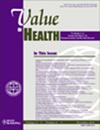利用马来西亚慢性心力衰竭患者的多中心横断面研究数据,将 AQoL-6D 直接和间接映射到 EQ-5D-5L 工具。
IF 4.9
2区 医学
Q1 ECONOMICS
引用次数: 0
摘要
目的:AQoL-6D 是一种基于偏好的通用测量方法,由于其测量范围更广,因此是评估慢性心力衰竭(HF)患者健康状况的 EQ-5D-5L 的替代方法,很有吸引力。然而,由于没有马来西亚的价值集,AQoL-6D 无法生成健康状态效用值 (HSUV) 以支持当地的经济评估。本研究旨在开发算法,根据 AQoL-6D 预测高频人群的 EQ-5D-5L HSUV:方法:研究使用了多中心队列中 419 名高频门诊患者的横断面数据。使用五组解释变量和 8 个模型(普通最小二乘法、托比特模型、删减最小绝对偏差模型、广义线性模型、两部分模型 [TPM]、基于贝塔回归的模型、调整有限因变量混合模型和多项式序数回归 [MLOGIT])尝试了直接和间接映射方法。模型的预测性能通过十倍交叉验证的平均绝对误差(MAE)和均方根误差(RMSE)进行评估。)此外,还对潜在的预测偏差进行了图形分析。然后确定了 RMSE 最低且无偏差的最佳模型:结果:在所评估的模型中,包括年龄、性别和五个 AQoL-6D 维度分数作为预测因子的 TPM 似乎是通过 AQoL-6D 直接预测 EQ-5D-5L HSUV 的最佳模型。TPM 的 MAE(0.0802)和 RMSE(0.1116)均最低,对 HSUV >0.2 的预测准确性也很高,且无明显偏差。为反应映射开发的 MLOGIT 模型的预测准确性不理想:本研究开发了一种潜在有用的映射算法,可在无法获得直接 EQ-5D-5L 数据的情况下,根据 HF 患者的 AQoL-6D 反应生成马来西亚 EQ-5D-5L HSUV。本文章由计算机程序翻译,如有差异,请以英文原文为准。
Direct and Indirect Mapping of Assessment of Quality of Life - 6 Dimensions (AQoL-6D) Onto EQ-5D-5L Utilities Using Data From a Multicenter, Cross-Sectional Study of Malaysians With Chronic Heart Failure
Objectives
The Assessment of Quality of Life - 6 Dimensions (AQoL-6D), a generic preference-based measure, is an appealing alternative to EQ-5D-5L for assessing health status in patients with chronic heart failure (HF), given its expanded scope. However, without a Malaysian value set, the AQoL-6D cannot generate health state utility values (HSUVs) to support local economic evaluations. This study intended to develop algorithms for predicting EQ-5D-5L HSUVs from AQoL-6D in an HF population.
Methods
Cross-sectional data from a multicenter cohort of 419 HF outpatients were used. Both direct and indirect mapping approaches were attempted using 5 sets of explanatory variables and 8 models (ordinary least squares, Tobit, censored least absolute deviations, generalized linear model, 2-part model [TPM], beta regression-based model, adjusted limited dependent variable mixture model, and multinomial ordinal regression [MLOGIT]). The models’ predictive performance was assessed through 10-fold cross-validated mean absolute error [MAE] and root mean squared error [RMSE]). Potential prediction bias was also examined graphically. The best-performing models, with the lowest RMSE and no bias, were then identified.
Results
Among the models evaluated, TPM, which included age, sex, and 5 AQoL-6D dimension scores as predictors, appears to be the best-performing model for directly predicting EQ-5D-5L HSUVs from AQoL-6D. TPM yielded the lowest MAE (0.0802) and RMSE (0.1116), and demonstrated predictive accuracy for HSUVs >0.2 without significant bias. A MLOGIT model developed for response mapping had suboptimal predictive accuracy.
Conclusions
This study developed potentially useful mapping algorithms for generating Malaysian EQ-5D-5L HSUVs from AQoL-6D responses among patients with HF when direct EQ-5D-5L data are unavailable.
求助全文
通过发布文献求助,成功后即可免费获取论文全文。
去求助
来源期刊

Value in Health
医学-卫生保健
CiteScore
6.90
自引率
6.70%
发文量
3064
审稿时长
3-8 weeks
期刊介绍:
Value in Health contains original research articles for pharmacoeconomics, health economics, and outcomes research (clinical, economic, and patient-reported outcomes/preference-based research), as well as conceptual and health policy articles that provide valuable information for health care decision-makers as well as the research community. As the official journal of ISPOR, Value in Health provides a forum for researchers, as well as health care decision-makers to translate outcomes research into health care decisions.
 求助内容:
求助内容: 应助结果提醒方式:
应助结果提醒方式:


